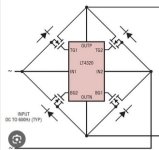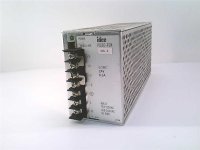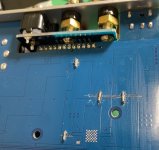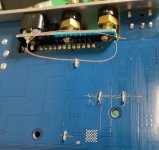What is this ideal diode bridge all about?Update, it is better with Mundorf cap in rectifier 👍
Any pics or schematic?
I didn't read through all pages, so I don"t know whether this problem was discussed before. When using a dual BTL MA12070 amp (SMSL PA3S) there is a strange phenomenon which I don't really understand. Using a good quality 24V 6A SMPS, putting any ferrite noise filter (either snap-on or toroidal type) on the supply cable the sound starts to crackle even at moderate volume levels. The amp actually goes to protection mode for short periods. This doesn't happen with analog (transfo-rectifier+filter cap) type power supplies.
Any similar experiences?
Oh yes, same thing happens with my friend's PA3S too, so it is not a problem only with my amp..... Actually the factory supplied SMPS is totally useless, because with that the cracking noise occurs without any input signal. Maybe my speakers present a too complex load for these amps ? (output filterless design!). It is two way DIY box with simple 2nd order X-over and average sensitivity.
Any similar experiences?
Oh yes, same thing happens with my friend's PA3S too, so it is not a problem only with my amp..... Actually the factory supplied SMPS is totally useless, because with that the cracking noise occurs without any input signal. Maybe my speakers present a too complex load for these amps ? (output filterless design!). It is two way DIY box with simple 2nd order X-over and average sensitivity.
It seems the “good” SMPS is not really good and must be checked/measured thoroughly. Probably a very good transmitter.
To avoid “car for sale, color red” syndrome you could mention brand and type and add a picture. Does it have a PE connection for instance? And is it connected to a PE wall socket? Open frame or adapter type? Is the “supply cable” the mains or the DC cable? Etc. etc.
To avoid “car for sale, color red” syndrome you could mention brand and type and add a picture. Does it have a PE connection for instance? And is it connected to a PE wall socket? Open frame or adapter type? Is the “supply cable” the mains or the DC cable? Etc. etc.
Last edited:
I have no problem with the factory SMPS and Pa3s.Also have tried Morsun LOF350 with no problem or strange sounds.Actually the factory supplied SMPS is totally useless, because with that the cracking noise occurs without any input signal.
But how long speaker cables do you run?
Since it filterless recomended is 60cm but i have runned it with 150cm with good result but it's EMI sensitive, yes.
If it is EMI straying in significantly from its loudspeakers cables into its own SMPS that would be fascinating and a challenge! We already knew output filtering is not luxury.
BTW in emergency cases just 4 x 4.7 uH 5A coils in the output do their work. Not perfect but it may be enough to test if the issue goes away. Best is in the casing but for testing directly on the output terminals is OK.
BTW in emergency cases just 4 x 4.7 uH 5A coils in the output do their work. Not perfect but it may be enough to test if the issue goes away. Best is in the casing but for testing directly on the output terminals is OK.
Last edited:
The power supply is an IDEC P3SE-F24, really one of the best in the league. On the output there is less than 15mV P-P noise is visible on a scope. The point is that I tried it with at least 4 different class D amps, (TPA3251, TPA 3255, MA5332 other MA12070), and none of them produced this anomaly even with larger inductance ferrite core filter on the DC cable. On the incoming side it is connected to a WAudio W4000 power line filter/conditioner.
My speaker cables are 7 feet long, low capacitance type (10x0.2mm flat foil, conductors separated 1/2")
My speaker cables are 7 feet long, low capacitance type (10x0.2mm flat foil, conductors separated 1/2")
Attachments
Feet?! Sorry metric here.
1. What about PE?
2. My guess is that all the other amplifiers are not filterless? I think Solve made a good suggestion.
3. Please try without the WAudio W4000.
1. What about PE?
2. My guess is that all the other amplifiers are not filterless? I think Solve made a good suggestion.
3. Please try without the WAudio W4000.
Last edited:
There is no such issue in my PA3s with factory supplied SMPS, but I agree with you - it's useless. Linear power supply sounds much better. Also I've tried this amp with 2*4 meters Kimber 8VS cable (it was only for test, usually I use 1 meter long cable), any cracks or noise. It will have bad measurements on lab equipment but not so noticable at first look. Speakers 6Ohm, 2-way with 88dB sensivityUsing a good quality 24V 6A SMPS, putting any ferrite noise filter (either snap-on or toroidal type) on the supply cable the sound starts to crackle even at moderate volume levels. The amp actually goes to protection mode for short periods. This doesn't happen with analog (transfo-rectifier+filter cap) type power supplies.
Any similar experiences?
Oh yes, same thing happens with my friend's PA3S too, so it is not a problem only with my amp..... Actually the factory supplied SMPS is totally useless, because with that the cracking noise occurs without any input signal
The point is that I tried it with at least 4 different class D amps, (TPA3251, TPA 3255, MA5332 other MA12070), and none of them produced this anomaly even with larger inductance ferrite core filter on the DC cable. On the incoming side it is connected to a WAudio W4000 power line filter/conditioner.
Do you get the same crackling effect if you put the ferrite on the mains input cable to the SMPS?
On the mains cable it didn'tmake any difference. With or without, the crackling was there.
But I think finally I solved it... Putting 4 Coilcraft 4.7 uH ferrite cored (closed case type) inductors in series with each speaker output reduced the crackling to almost zero. Sometimes at higher volumes with certain types of music it happens, but I can live with that.... Also placing the SMPS further from the amp reduces the happenings even more.
I guess the PA3S is particularly sensitive to EMI-RFI, so this filterless design idea is probably not a winning ticket in class D design.
But I think finally I solved it... Putting 4 Coilcraft 4.7 uH ferrite cored (closed case type) inductors in series with each speaker output reduced the crackling to almost zero. Sometimes at higher volumes with certain types of music it happens, but I can live with that.... Also placing the SMPS further from the amp reduces the happenings even more.
I guess the PA3S is particularly sensitive to EMI-RFI, so this filterless design idea is probably not a winning ticket in class D design.

The other way around, MA12070 in that PA3S is emitting too much EMI when used filterless. Your PSU seems to pick it up from the too long cables/antennas and feed it back choking the MA12070. The Infineon document also mentions to use an CLC power supply filter. Probably also lacking in that amplifier?!
Filterless and heatsinkless are costcutting and not technical improvements (in fact the inverse) and therefor marketing tools. Datasheet and marketing say "filterless" with loudspeakercables of 40 to 60 cm (who has such short ones?), their own document and reality show filtering to be a necessity:
https://www.infineon.com/dgdl/Infin...N.pdf?fileId=5546d46264a8de7e0164b359d78016f6
For this reason the advice is to pick an amplifier with output filtering. Not aware of the innards of the PA3S as it does not meet minimum criteria but a small PCB with output filtering is designed in an hour max. Internal and closer to the IC is best.
Filterless and heatsinkless are costcutting and not technical improvements (in fact the inverse) and therefor marketing tools. Datasheet and marketing say "filterless" with loudspeakercables of 40 to 60 cm (who has such short ones?), their own document and reality show filtering to be a necessity:
https://www.infineon.com/dgdl/Infin...N.pdf?fileId=5546d46264a8de7e0164b359d78016f6
For this reason the advice is to pick an amplifier with output filtering. Not aware of the innards of the PA3S as it does not meet minimum criteria but a small PCB with output filtering is designed in an hour max. Internal and closer to the IC is best.
Last edited:
Today I've tried the simplest variant to put ferrites, but there are duplicate conductors on the board in other layers, I had to short-circuit them back. Owners of PA3s, don't try this methodNot aware of the innards of the PA3S as it does not meet minimum criteria but a small PCB with output filtering is designed in an hour max. Internal and closer to the IC is best.
Attachments
At 1st it very uncomfortable to desloder it. At second, we'll have to cut that board from both sides, it's all very inconvenient there. Seems to me it's better to made this board with new design, than cut it from all sidesAt the other side/with a new small PCB.
We cant to dismantle rear aluminium panel withouth desoldering that additional pcb with RCA and banana plug connectors. On that board there are no conveniently method to put filter. Think that better solution will be throw away this small PCB, and connect it to mainboard with cables (and solder filter before this cables)

- Home
- Amplifiers
- Class D
- Infineon MA12070 Class D



